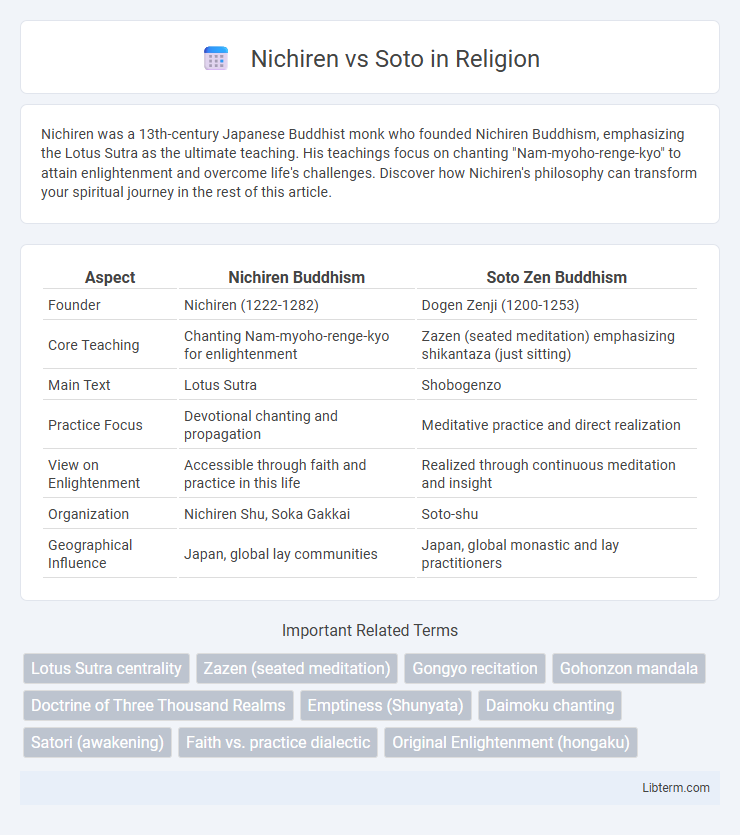Nichiren was a 13th-century Japanese Buddhist monk who founded Nichiren Buddhism, emphasizing the Lotus Sutra as the ultimate teaching. His teachings focus on chanting "Nam-myoho-renge-kyo" to attain enlightenment and overcome life's challenges. Discover how Nichiren's philosophy can transform your spiritual journey in the rest of this article.
Table of Comparison
| Aspect | Nichiren Buddhism | Soto Zen Buddhism |
|---|---|---|
| Founder | Nichiren (1222-1282) | Dogen Zenji (1200-1253) |
| Core Teaching | Chanting Nam-myoho-renge-kyo for enlightenment | Zazen (seated meditation) emphasizing shikantaza (just sitting) |
| Main Text | Lotus Sutra | Shobogenzo |
| Practice Focus | Devotional chanting and propagation | Meditative practice and direct realization |
| View on Enlightenment | Accessible through faith and practice in this life | Realized through continuous meditation and insight |
| Organization | Nichiren Shu, Soka Gakkai | Soto-shu |
| Geographical Influence | Japan, global lay communities | Japan, global monastic and lay practitioners |
Introduction to Nichiren and Soto Schools
Nichiren Buddhism, founded by the 13th-century Japanese monk Nichiren, centers on the Lotus Sutra as the ultimate teaching and emphasizes chanting Nam-myoho-renge-kyo for enlightenment. In contrast, the Soto school, established by Dogen Zen in the 13th century, focuses on the practice of zazen meditation and teachings derived from the Shobogenzo. Both schools represent major branches of Japanese Buddhism, with Nichiren advocating faith and chanting, while Soto highlights silent meditation and direct experience.
Historical Origins and Development
Nichiren Buddhism originated in 13th-century Japan, founded by the monk Nichiren who emphasized devotion to the Lotus Sutra as the supreme teaching. In contrast, Soto Zen developed from the teachings of Dogen Zenji in the 13th century, focusing on Shikantaza, or "just sitting," as the core meditation practice. Both schools evolved independently, with Nichiren Buddhism stressing chanting and doctrinal study, while Soto Zen prioritized silent meditation and monastic discipline.
Founders: Nichiren vs Dogen
Nichiren, the founder of Nichiren Buddhism in 13th-century Japan, emphasized the Lotus Sutra as the supreme teaching, advocating for chanting "Nam-myoho-renge-kyo" as a path to enlightenment. In contrast, Dogen, the 13th-century founder of Soto Zen, focused on "shikantaza" or "just sitting" meditation, promoting a direct experience of enlightenment through seated meditation practice. While Nichiren stressed devotion and doctrinal supremacy, Dogen emphasized zazen and the inseparability of practice and enlightenment.
Core Doctrines and Teachings
Nichiren Buddhism centers on the Lotus Sutra's exclusive supremacy, emphasizing chanting "Nam-myoho-renge-kyo" as the path to enlightenment for all. Soto Zen prioritizes shikantaza, or "just sitting," promoting direct experience of Buddha-nature through silent meditation without reliance on scriptures. Nichiren views faith and chanting as transformational, while Soto stresses meditation practice and realization of inherent enlightenment.
Primary Practices and Rituals
Nichiren Buddhism centers its primary practice on chanting the Odaimoku, "Nam-myoho-renge-kyo," to directly invoke the Lotus Sutra's enlightenment. In contrast, Soto Zen emphasizes zazen, or seated meditation, as the core ritual, focusing on shikantaza, "just sitting," to realize inherent Buddha nature. Rituals in Nichiren tradition include reciting portions of the Lotus Sutra and gongyo services, while Soto Zen incorporates formal bowing, chanting of sutras, and periodic sesshin meditation retreats.
Key Texts and Scriptures
Nichiren Buddhism centers its teachings primarily on the Lotus Sutra, especially the 14th chapter, which Nichiren regarded as the ultimate scripture revealing the true nature of the Buddha. In contrast, Soto Zen emphasizes the foundational texts of the Mahayana tradition, such as the Shobogenzo by Dogen Zenji, which expounds on the practice of zazen and the realization of Buddha-nature. The Lotus Sutra in Nichiren practice is recited daily as a direct expression of faith and enlightenment, while Soto Zen focuses on meditative awareness grounded in Dogen's philosophical and instructional writings.
Approach to Enlightenment
Nichiren Buddhism emphasizes the chanting of the Daimoku, "Nam-myoho-renge-kyo," as the direct and exclusive path to enlightenment, focusing on the Lotus Sutra as the ultimate teaching. Soto Zen prioritizes "shikantaza" or "just sitting," a form of silent meditation without specific objects, stressing gradual insight through mindful presence and non-attachment. Nichiren's approach is more doctrinal and practice-centered, aiming for immediate engagement with the mystical law, while Soto Zen promotes experiential realization through sustained, non-conceptual awareness.
Community Structure and Leadership
Nichiren Buddhism emphasizes a centralized community structure with strong leadership often centered around a single charismatic founder figure, fostering collective chanting and lay participation. In contrast, Soto Zen operates with a more decentralized monastic system where abbots oversee individual temples, promoting meditation practice (zazen) as a communal yet individually guided experience. Nichiren groups typically organize lay and clergy hierarchically, while Soto Zen communities balance monastic authority with lay involvement through local temple networks.
Influence in Modern Buddhism
Nichiren Buddhism, founded by Nichiren in 13th-century Japan, emphasizes the Lotus Sutra and chanting "Nam-myoho-renge-kyo" to achieve enlightenment, profoundly influencing modern Buddhist activism and social engagement. Soto Zen, established by Dogen, prioritizes shikantaza or "just sitting" meditation, shaping contemporary mindfulness practices and monastic traditions globally. Both sects contribute uniquely to modern Buddhism: Nichiren through dynamic lay participation and Soto through meditative depth and disciplined practice.
Comparative Summary and Lasting Impact
Nichiren Buddhism emphasizes the chanting of Nam-myoho-renge-kyo as the sole path to enlightenment, contrasting with Soto Zen's focus on silent zazen meditation and shikantaza ("just sitting"). Nichiren's approach actively engages lay practitioners with a strong doctrinal foundation centered on the Lotus Sutra, while Soto Zen prioritizes direct experience through mindfulness and non-dual awareness. The lasting impact of Nichiren Buddhism is evident in its global movements advocating social engagement and personal empowerment, whereas Soto Zen has significantly influenced Western mindfulness practices and spiritual contemplation.
Nichiren Infographic

 libterm.com
libterm.com